Analysis of Vodafone's Business Communication and Industry Dynamics
VerifiedAdded on 2023/01/19
|12
|3394
|69
Report
AI Summary
This report provides a comprehensive analysis of Vodafone's business communication, delving into industry data, key businesses, customers, suppliers, competitors, and performance metrics. It includes a SWOT analysis to evaluate the company's strengths, weaknesses, opportunities, and threats, as well as an application of Porter's Five Forces Model to assess its competitive position. The report identifies key issues faced by Vodafone, such as employee turnover and resource utilization, and explores management and operational challenges. It also incorporates a reflection on the author's learning experience, including the use of the VARK model for different learning styles and the application of Tuckman's model for team development and Belbin's theory for effective communication and problem-solving within a team setting.
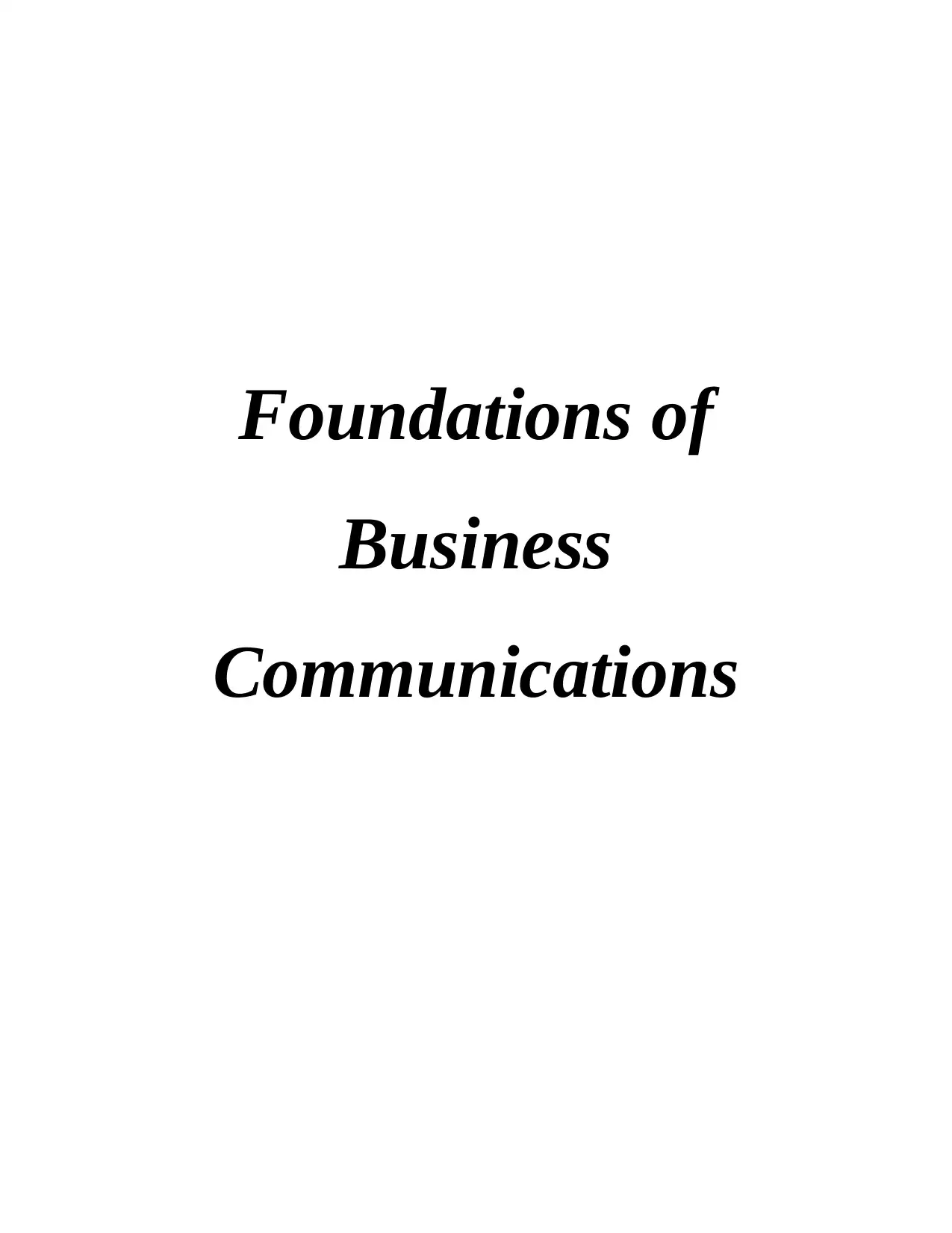
Foundations of
Business
Communications
Business
Communications
Paraphrase This Document
Need a fresh take? Get an instant paraphrase of this document with our AI Paraphraser

Table of Contents
INTRODUCTION...........................................................................................................................3
Part 1................................................................................................................................................3
Topic industry data......................................................................................................................3
Key businesses, customers, suppliers, competitors, performance, strengths and weaknesses
and challenges faced...................................................................................................................3
A SWOT analysis of the Business Company.............................................................................5
Analyse the competitive position of the organisation through Porter’s Five Forces Model.......5
Identifying key issues faced, resourcing and any management/ operational issues facing the
owner/ managers of the business.................................................................................................7
Part 2................................................................................................................................................8
Reflection....................................................................................................................................8
CONCLUSION..............................................................................................................................10
REFRENCES.................................................................................................................................12
INTRODUCTION...........................................................................................................................3
Part 1................................................................................................................................................3
Topic industry data......................................................................................................................3
Key businesses, customers, suppliers, competitors, performance, strengths and weaknesses
and challenges faced...................................................................................................................3
A SWOT analysis of the Business Company.............................................................................5
Analyse the competitive position of the organisation through Porter’s Five Forces Model.......5
Identifying key issues faced, resourcing and any management/ operational issues facing the
owner/ managers of the business.................................................................................................7
Part 2................................................................................................................................................8
Reflection....................................................................................................................................8
CONCLUSION..............................................................................................................................10
REFRENCES.................................................................................................................................12

INTRODUCTION
Business communication is consider as a process in which their will sharing of
informations or message will be done within or outside an organisation. At a workplace effective
business communication is practice which show how employer and employees interact with each
other in order to attain organization goal (Brenner, Zarnekow and Wittig, 2012). Through this
they able to enhance company production and effectiveness as well as it will also reduce
mistakes. Organisation selected for this assignment is Vodafone which is a public limited
company operating in telecommunication industry. It is founded by Ernest Harrison and Gerry
Whent in the year 1991 and its headquarter is located at London, United kingdom. The
respective firm offer products like digital television, mobile phone, broadband, internet television
and many others at worldwide level. They are currently facing business issue of high employees
turnover. Topics which are going to explain in this report are understanding of different models
as well as analysis tools that get affected due to external environment. Along with this it will also
include personal reflection related to understanding and learning of report.
Part 1
Topic industry data
Vodafone is one of the leading company which is dealing in telecommunication sector. It
is a British multinational company which is providing different products and services to all
around the world. Vodafone company was established in 1991 and founder of this organisation is
Ernest Harrison and Gerry Whent. Headquarter of this organisation is located in London and it is
providing its products in different parts of the world (Campbell, 2013). Vodafone company is
current facing some major issues in business which is affecting its productivity as well as
performance. Due to increase in turnover ratio performance of employees in continuously
decreasing as well as they are not able to accomplish set goals in effective and efficient manner.
It is very important for Vodafone company to manage this issues and improve organisational
performance.
Key businesses, customers, suppliers, competitors, performance, strengths and weaknesses and
challenges faced
Vodafone is British telecommunication company which offer their products in
international level. The key business of respective company is help companies in getting
Business communication is consider as a process in which their will sharing of
informations or message will be done within or outside an organisation. At a workplace effective
business communication is practice which show how employer and employees interact with each
other in order to attain organization goal (Brenner, Zarnekow and Wittig, 2012). Through this
they able to enhance company production and effectiveness as well as it will also reduce
mistakes. Organisation selected for this assignment is Vodafone which is a public limited
company operating in telecommunication industry. It is founded by Ernest Harrison and Gerry
Whent in the year 1991 and its headquarter is located at London, United kingdom. The
respective firm offer products like digital television, mobile phone, broadband, internet television
and many others at worldwide level. They are currently facing business issue of high employees
turnover. Topics which are going to explain in this report are understanding of different models
as well as analysis tools that get affected due to external environment. Along with this it will also
include personal reflection related to understanding and learning of report.
Part 1
Topic industry data
Vodafone is one of the leading company which is dealing in telecommunication sector. It
is a British multinational company which is providing different products and services to all
around the world. Vodafone company was established in 1991 and founder of this organisation is
Ernest Harrison and Gerry Whent. Headquarter of this organisation is located in London and it is
providing its products in different parts of the world (Campbell, 2013). Vodafone company is
current facing some major issues in business which is affecting its productivity as well as
performance. Due to increase in turnover ratio performance of employees in continuously
decreasing as well as they are not able to accomplish set goals in effective and efficient manner.
It is very important for Vodafone company to manage this issues and improve organisational
performance.
Key businesses, customers, suppliers, competitors, performance, strengths and weaknesses and
challenges faced
Vodafone is British telecommunication company which offer their products in
international level. The key business of respective company is help companies in getting
⊘ This is a preview!⊘
Do you want full access?
Subscribe today to unlock all pages.

Trusted by 1+ million students worldwide

succeeded in a digital world through their connectivity (Vodafone business, 2019). They also
help business units of all size as well as sectors in order to develop or connect for the better
future. For this they offer products like mobile communication, fixed communication, unified
communication, internet of things, cloud and hosting, carrier services and many more.
The customers of Vodafone are companies of all level (large, middle and small) as well
as local and international peoples. There are approx 444 million customers of respective
company and from that 19.5 millions are from United Kingdom (Company history, 2019). Along
with this competitors of Vodafone are BT Group, America Movil, Telefonica, Airtel, Reliance
Jio, China Telecom, SoftBank, Verizon, Deutsche TeleKom and many more. The supplier of
Vodafone are allocated all over the world as well as they closely work to their supplier in order
to provide innovative ideas or solution in the ethical environment (Suppliers, 2019). The
resources for suppliers are related to sourcing and procurement, health and safety and many
others.
Vodafone has enhanced their performance successfully by conducting merging with Idea.
From august 2018 till now respective company is increasing their business performance day by
day.
Strength of respective company are its brand awareness, superior customer service,
network and many more as well as their weakness are continuous growing emerging marketplace
Illustration 1: Vodafone performance
Source: Vodafone, Idea Data Performance Benefited by Merger, Both Brands Show
Notable Improvements: Ookla, 2019
help business units of all size as well as sectors in order to develop or connect for the better
future. For this they offer products like mobile communication, fixed communication, unified
communication, internet of things, cloud and hosting, carrier services and many more.
The customers of Vodafone are companies of all level (large, middle and small) as well
as local and international peoples. There are approx 444 million customers of respective
company and from that 19.5 millions are from United Kingdom (Company history, 2019). Along
with this competitors of Vodafone are BT Group, America Movil, Telefonica, Airtel, Reliance
Jio, China Telecom, SoftBank, Verizon, Deutsche TeleKom and many more. The supplier of
Vodafone are allocated all over the world as well as they closely work to their supplier in order
to provide innovative ideas or solution in the ethical environment (Suppliers, 2019). The
resources for suppliers are related to sourcing and procurement, health and safety and many
others.
Vodafone has enhanced their performance successfully by conducting merging with Idea.
From august 2018 till now respective company is increasing their business performance day by
day.
Strength of respective company are its brand awareness, superior customer service,
network and many more as well as their weakness are continuous growing emerging marketplace
Illustration 1: Vodafone performance
Source: Vodafone, Idea Data Performance Benefited by Merger, Both Brands Show
Notable Improvements: Ookla, 2019
Paraphrase This Document
Need a fresh take? Get an instant paraphrase of this document with our AI Paraphraser
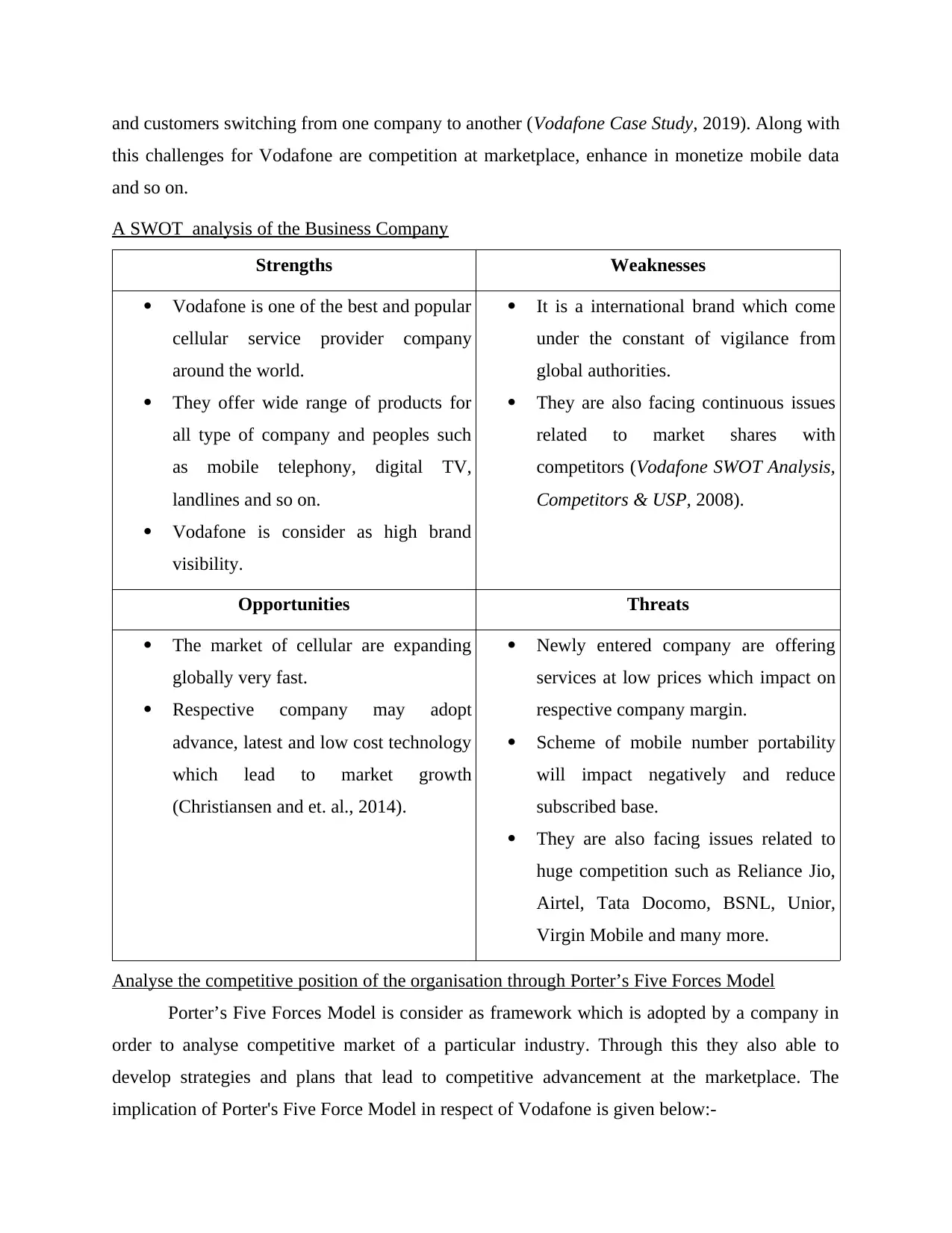
and customers switching from one company to another (Vodafone Case Study, 2019). Along with
this challenges for Vodafone are competition at marketplace, enhance in monetize mobile data
and so on.
A SWOT analysis of the Business Company
Strengths Weaknesses
Vodafone is one of the best and popular
cellular service provider company
around the world.
They offer wide range of products for
all type of company and peoples such
as mobile telephony, digital TV,
landlines and so on.
Vodafone is consider as high brand
visibility.
It is a international brand which come
under the constant of vigilance from
global authorities.
They are also facing continuous issues
related to market shares with
competitors (Vodafone SWOT Analysis,
Competitors & USP, 2008).
Opportunities Threats
The market of cellular are expanding
globally very fast.
Respective company may adopt
advance, latest and low cost technology
which lead to market growth
(Christiansen and et. al., 2014).
Newly entered company are offering
services at low prices which impact on
respective company margin.
Scheme of mobile number portability
will impact negatively and reduce
subscribed base.
They are also facing issues related to
huge competition such as Reliance Jio,
Airtel, Tata Docomo, BSNL, Unior,
Virgin Mobile and many more.
Analyse the competitive position of the organisation through Porter’s Five Forces Model
Porter’s Five Forces Model is consider as framework which is adopted by a company in
order to analyse competitive market of a particular industry. Through this they also able to
develop strategies and plans that lead to competitive advancement at the marketplace. The
implication of Porter's Five Force Model in respect of Vodafone is given below:-
this challenges for Vodafone are competition at marketplace, enhance in monetize mobile data
and so on.
A SWOT analysis of the Business Company
Strengths Weaknesses
Vodafone is one of the best and popular
cellular service provider company
around the world.
They offer wide range of products for
all type of company and peoples such
as mobile telephony, digital TV,
landlines and so on.
Vodafone is consider as high brand
visibility.
It is a international brand which come
under the constant of vigilance from
global authorities.
They are also facing continuous issues
related to market shares with
competitors (Vodafone SWOT Analysis,
Competitors & USP, 2008).
Opportunities Threats
The market of cellular are expanding
globally very fast.
Respective company may adopt
advance, latest and low cost technology
which lead to market growth
(Christiansen and et. al., 2014).
Newly entered company are offering
services at low prices which impact on
respective company margin.
Scheme of mobile number portability
will impact negatively and reduce
subscribed base.
They are also facing issues related to
huge competition such as Reliance Jio,
Airtel, Tata Docomo, BSNL, Unior,
Virgin Mobile and many more.
Analyse the competitive position of the organisation through Porter’s Five Forces Model
Porter’s Five Forces Model is consider as framework which is adopted by a company in
order to analyse competitive market of a particular industry. Through this they also able to
develop strategies and plans that lead to competitive advancement at the marketplace. The
implication of Porter's Five Force Model in respect of Vodafone is given below:-
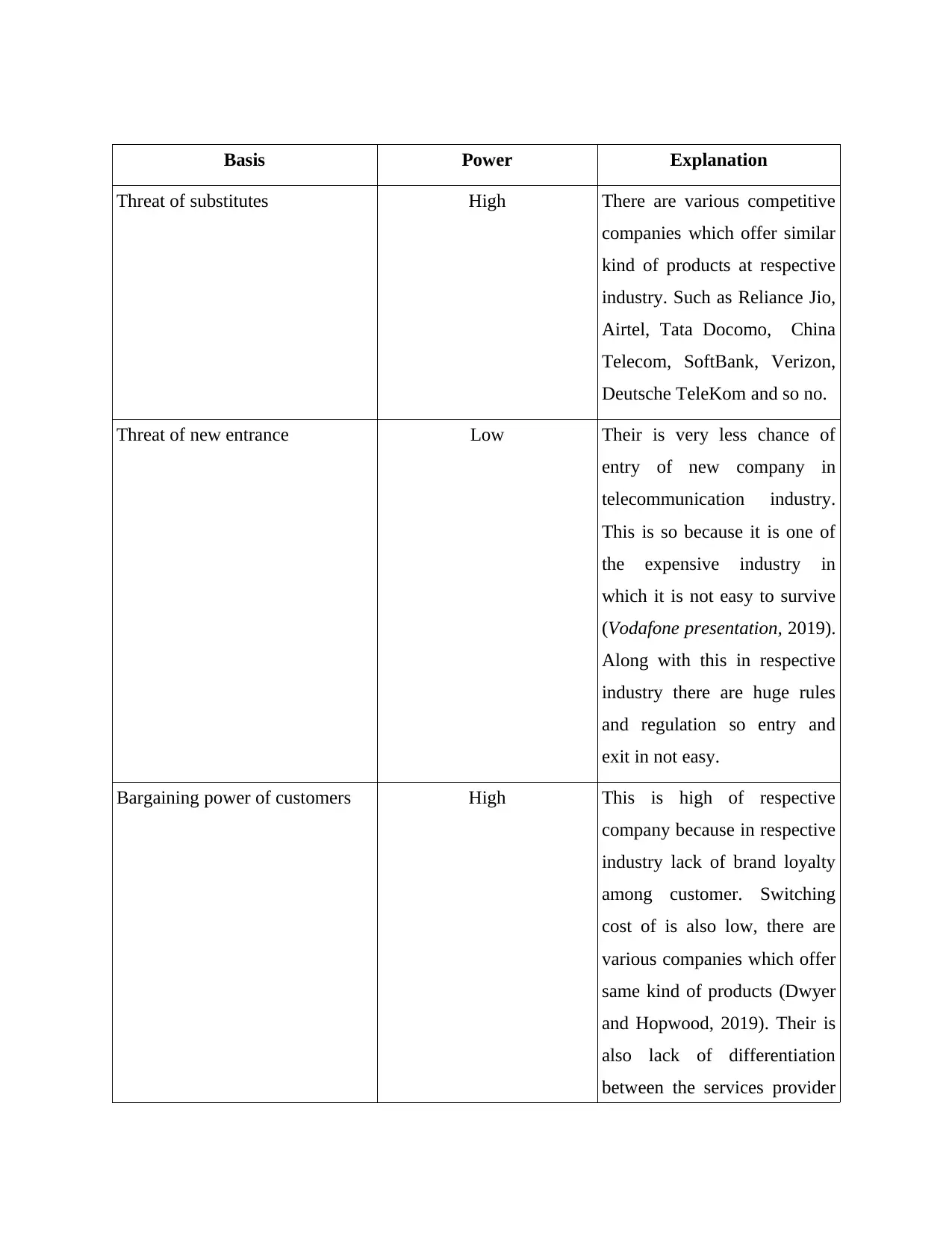
Basis Power Explanation
Threat of substitutes High There are various competitive
companies which offer similar
kind of products at respective
industry. Such as Reliance Jio,
Airtel, Tata Docomo, China
Telecom, SoftBank, Verizon,
Deutsche TeleKom and so no.
Threat of new entrance Low Their is very less chance of
entry of new company in
telecommunication industry.
This is so because it is one of
the expensive industry in
which it is not easy to survive
(Vodafone presentation, 2019).
Along with this in respective
industry there are huge rules
and regulation so entry and
exit in not easy.
Bargaining power of customers High This is high of respective
company because in respective
industry lack of brand loyalty
among customer. Switching
cost of is also low, there are
various companies which offer
same kind of products (Dwyer
and Hopwood, 2019). Their is
also lack of differentiation
between the services provider
Threat of substitutes High There are various competitive
companies which offer similar
kind of products at respective
industry. Such as Reliance Jio,
Airtel, Tata Docomo, China
Telecom, SoftBank, Verizon,
Deutsche TeleKom and so no.
Threat of new entrance Low Their is very less chance of
entry of new company in
telecommunication industry.
This is so because it is one of
the expensive industry in
which it is not easy to survive
(Vodafone presentation, 2019).
Along with this in respective
industry there are huge rules
and regulation so entry and
exit in not easy.
Bargaining power of customers High This is high of respective
company because in respective
industry lack of brand loyalty
among customer. Switching
cost of is also low, there are
various companies which offer
same kind of products (Dwyer
and Hopwood, 2019). Their is
also lack of differentiation
between the services provider
⊘ This is a preview!⊘
Do you want full access?
Subscribe today to unlock all pages.

Trusted by 1+ million students worldwide
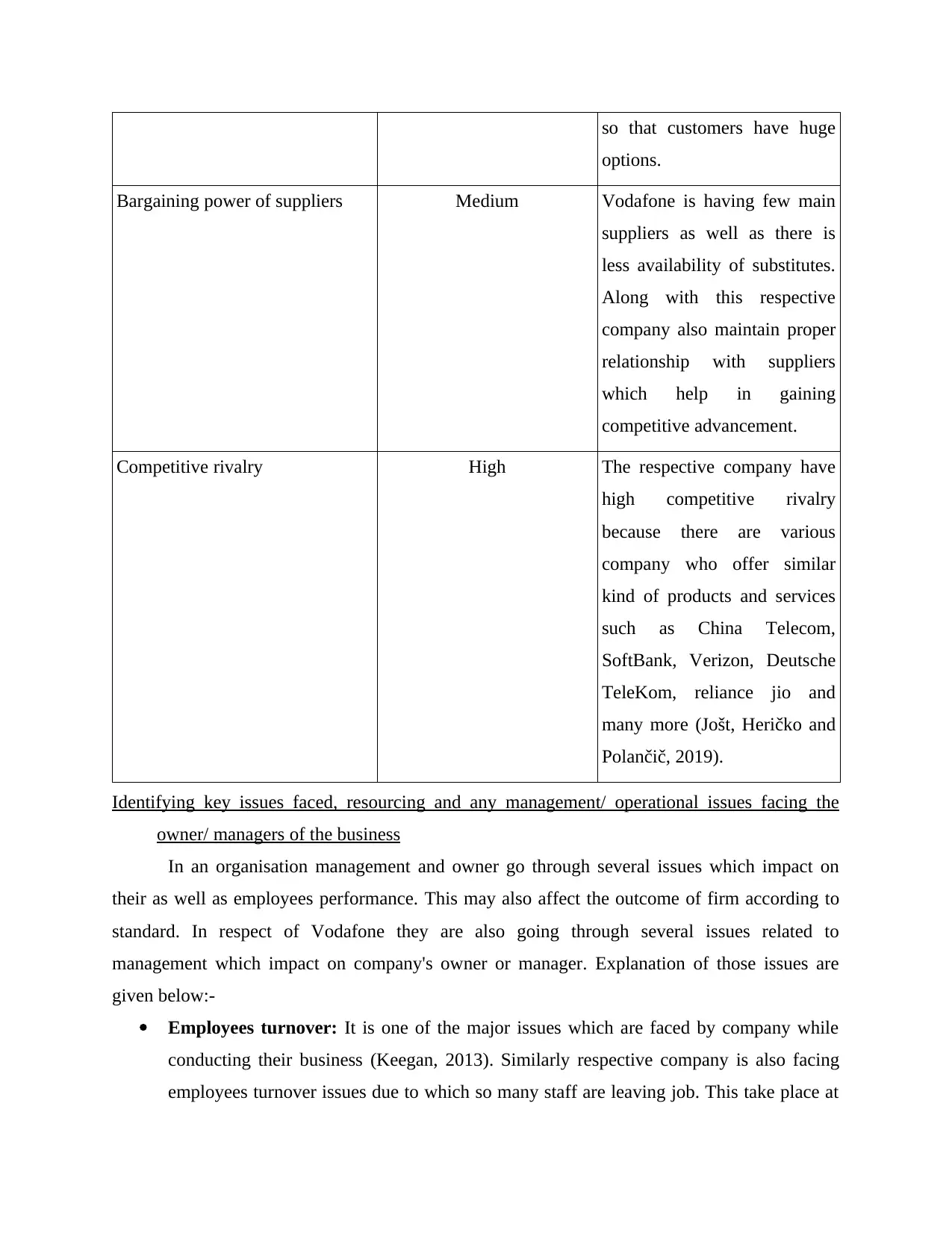
so that customers have huge
options.
Bargaining power of suppliers Medium Vodafone is having few main
suppliers as well as there is
less availability of substitutes.
Along with this respective
company also maintain proper
relationship with suppliers
which help in gaining
competitive advancement.
Competitive rivalry High The respective company have
high competitive rivalry
because there are various
company who offer similar
kind of products and services
such as China Telecom,
SoftBank, Verizon, Deutsche
TeleKom, reliance jio and
many more (Jošt, Heričko and
Polančič, 2019).
Identifying key issues faced, resourcing and any management/ operational issues facing the
owner/ managers of the business
In an organisation management and owner go through several issues which impact on
their as well as employees performance. This may also affect the outcome of firm according to
standard. In respect of Vodafone they are also going through several issues related to
management which impact on company's owner or manager. Explanation of those issues are
given below:-
Employees turnover: It is one of the major issues which are faced by company while
conducting their business (Keegan, 2013). Similarly respective company is also facing
employees turnover issues due to which so many staff are leaving job. This take place at
options.
Bargaining power of suppliers Medium Vodafone is having few main
suppliers as well as there is
less availability of substitutes.
Along with this respective
company also maintain proper
relationship with suppliers
which help in gaining
competitive advancement.
Competitive rivalry High The respective company have
high competitive rivalry
because there are various
company who offer similar
kind of products and services
such as China Telecom,
SoftBank, Verizon, Deutsche
TeleKom, reliance jio and
many more (Jošt, Heričko and
Polančič, 2019).
Identifying key issues faced, resourcing and any management/ operational issues facing the
owner/ managers of the business
In an organisation management and owner go through several issues which impact on
their as well as employees performance. This may also affect the outcome of firm according to
standard. In respect of Vodafone they are also going through several issues related to
management which impact on company's owner or manager. Explanation of those issues are
given below:-
Employees turnover: It is one of the major issues which are faced by company while
conducting their business (Keegan, 2013). Similarly respective company is also facing
employees turnover issues due to which so many staff are leaving job. This take place at
Paraphrase This Document
Need a fresh take? Get an instant paraphrase of this document with our AI Paraphraser
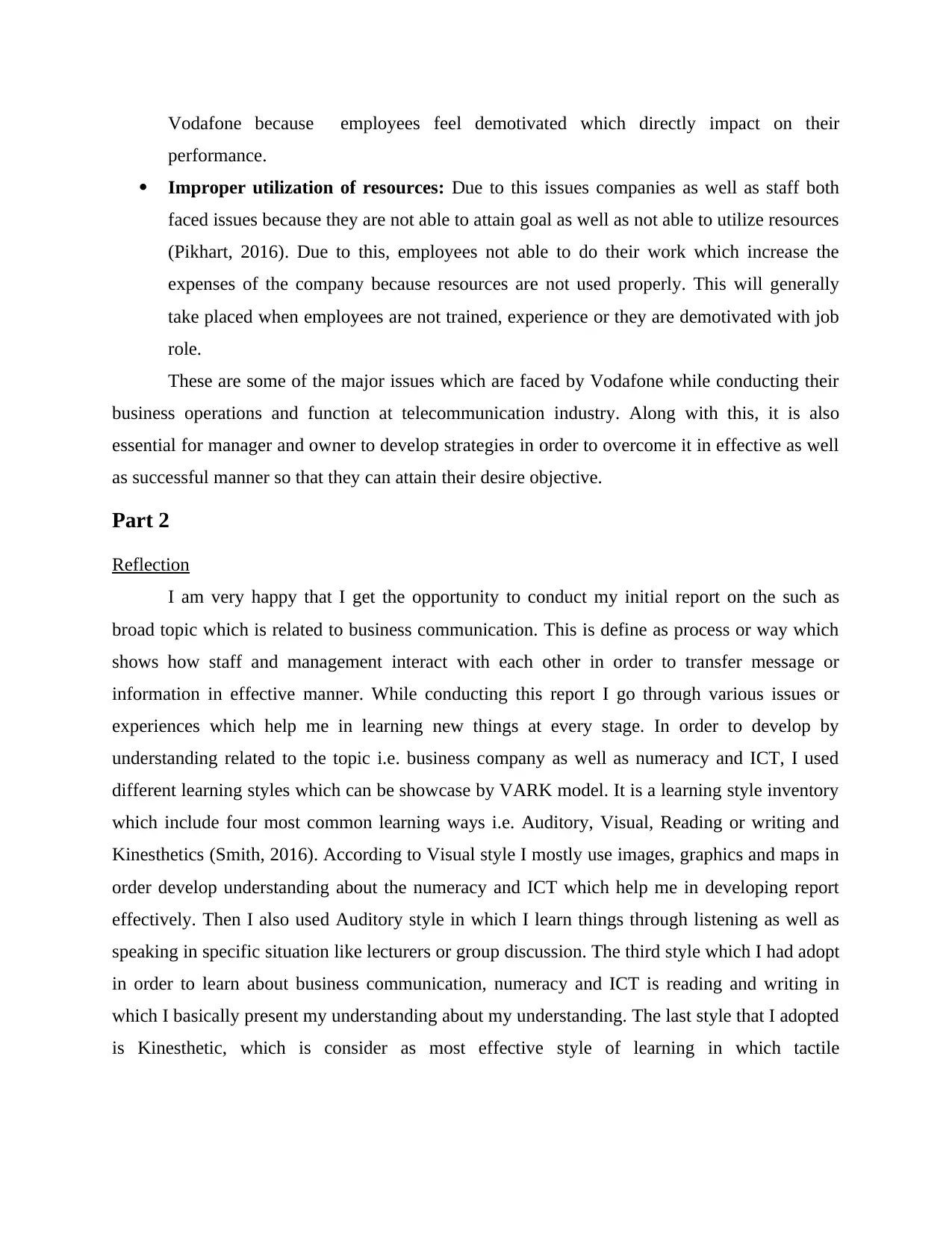
Vodafone because employees feel demotivated which directly impact on their
performance.
Improper utilization of resources: Due to this issues companies as well as staff both
faced issues because they are not able to attain goal as well as not able to utilize resources
(Pikhart, 2016). Due to this, employees not able to do their work which increase the
expenses of the company because resources are not used properly. This will generally
take placed when employees are not trained, experience or they are demotivated with job
role.
These are some of the major issues which are faced by Vodafone while conducting their
business operations and function at telecommunication industry. Along with this, it is also
essential for manager and owner to develop strategies in order to overcome it in effective as well
as successful manner so that they can attain their desire objective.
Part 2
Reflection
I am very happy that I get the opportunity to conduct my initial report on the such as
broad topic which is related to business communication. This is define as process or way which
shows how staff and management interact with each other in order to transfer message or
information in effective manner. While conducting this report I go through various issues or
experiences which help me in learning new things at every stage. In order to develop by
understanding related to the topic i.e. business company as well as numeracy and ICT, I used
different learning styles which can be showcase by VARK model. It is a learning style inventory
which include four most common learning ways i.e. Auditory, Visual, Reading or writing and
Kinesthetics (Smith, 2016). According to Visual style I mostly use images, graphics and maps in
order develop understanding about the numeracy and ICT which help me in developing report
effectively. Then I also used Auditory style in which I learn things through listening as well as
speaking in specific situation like lecturers or group discussion. The third style which I had adopt
in order to learn about business communication, numeracy and ICT is reading and writing in
which I basically present my understanding about my understanding. The last style that I adopted
is Kinesthetic, which is consider as most effective style of learning in which tactile
performance.
Improper utilization of resources: Due to this issues companies as well as staff both
faced issues because they are not able to attain goal as well as not able to utilize resources
(Pikhart, 2016). Due to this, employees not able to do their work which increase the
expenses of the company because resources are not used properly. This will generally
take placed when employees are not trained, experience or they are demotivated with job
role.
These are some of the major issues which are faced by Vodafone while conducting their
business operations and function at telecommunication industry. Along with this, it is also
essential for manager and owner to develop strategies in order to overcome it in effective as well
as successful manner so that they can attain their desire objective.
Part 2
Reflection
I am very happy that I get the opportunity to conduct my initial report on the such as
broad topic which is related to business communication. This is define as process or way which
shows how staff and management interact with each other in order to transfer message or
information in effective manner. While conducting this report I go through various issues or
experiences which help me in learning new things at every stage. In order to develop by
understanding related to the topic i.e. business company as well as numeracy and ICT, I used
different learning styles which can be showcase by VARK model. It is a learning style inventory
which include four most common learning ways i.e. Auditory, Visual, Reading or writing and
Kinesthetics (Smith, 2016). According to Visual style I mostly use images, graphics and maps in
order develop understanding about the numeracy and ICT which help me in developing report
effectively. Then I also used Auditory style in which I learn things through listening as well as
speaking in specific situation like lecturers or group discussion. The third style which I had adopt
in order to learn about business communication, numeracy and ICT is reading and writing in
which I basically present my understanding about my understanding. The last style that I adopted
is Kinesthetic, which is consider as most effective style of learning in which tactile
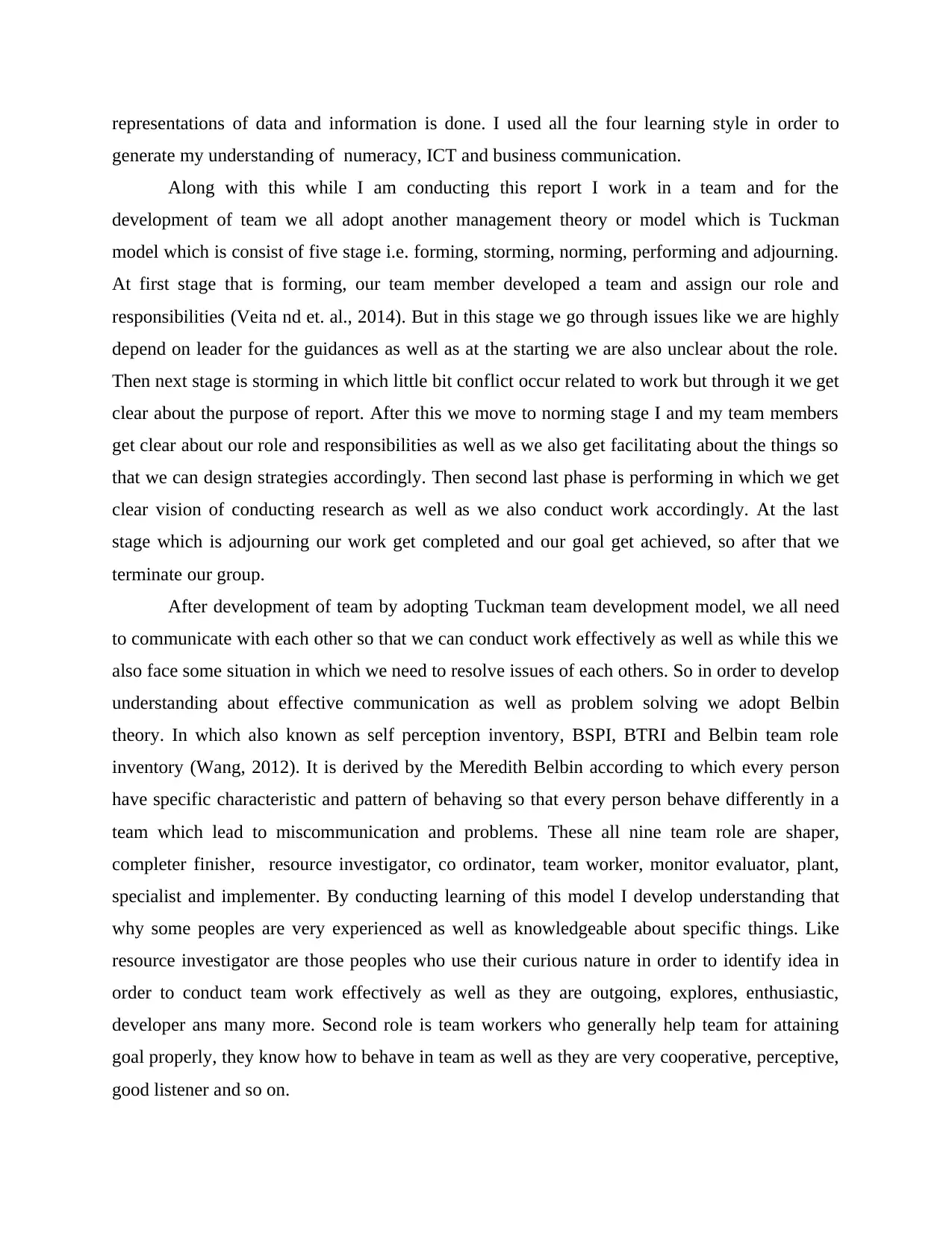
representations of data and information is done. I used all the four learning style in order to
generate my understanding of numeracy, ICT and business communication.
Along with this while I am conducting this report I work in a team and for the
development of team we all adopt another management theory or model which is Tuckman
model which is consist of five stage i.e. forming, storming, norming, performing and adjourning.
At first stage that is forming, our team member developed a team and assign our role and
responsibilities (Veita nd et. al., 2014). But in this stage we go through issues like we are highly
depend on leader for the guidances as well as at the starting we are also unclear about the role.
Then next stage is storming in which little bit conflict occur related to work but through it we get
clear about the purpose of report. After this we move to norming stage I and my team members
get clear about our role and responsibilities as well as we also get facilitating about the things so
that we can design strategies accordingly. Then second last phase is performing in which we get
clear vision of conducting research as well as we also conduct work accordingly. At the last
stage which is adjourning our work get completed and our goal get achieved, so after that we
terminate our group.
After development of team by adopting Tuckman team development model, we all need
to communicate with each other so that we can conduct work effectively as well as while this we
also face some situation in which we need to resolve issues of each others. So in order to develop
understanding about effective communication as well as problem solving we adopt Belbin
theory. In which also known as self perception inventory, BSPI, BTRI and Belbin team role
inventory (Wang, 2012). It is derived by the Meredith Belbin according to which every person
have specific characteristic and pattern of behaving so that every person behave differently in a
team which lead to miscommunication and problems. These all nine team role are shaper,
completer finisher, resource investigator, co ordinator, team worker, monitor evaluator, plant,
specialist and implementer. By conducting learning of this model I develop understanding that
why some peoples are very experienced as well as knowledgeable about specific things. Like
resource investigator are those peoples who use their curious nature in order to identify idea in
order to conduct team work effectively as well as they are outgoing, explores, enthusiastic,
developer ans many more. Second role is team workers who generally help team for attaining
goal properly, they know how to behave in team as well as they are very cooperative, perceptive,
good listener and so on.
generate my understanding of numeracy, ICT and business communication.
Along with this while I am conducting this report I work in a team and for the
development of team we all adopt another management theory or model which is Tuckman
model which is consist of five stage i.e. forming, storming, norming, performing and adjourning.
At first stage that is forming, our team member developed a team and assign our role and
responsibilities (Veita nd et. al., 2014). But in this stage we go through issues like we are highly
depend on leader for the guidances as well as at the starting we are also unclear about the role.
Then next stage is storming in which little bit conflict occur related to work but through it we get
clear about the purpose of report. After this we move to norming stage I and my team members
get clear about our role and responsibilities as well as we also get facilitating about the things so
that we can design strategies accordingly. Then second last phase is performing in which we get
clear vision of conducting research as well as we also conduct work accordingly. At the last
stage which is adjourning our work get completed and our goal get achieved, so after that we
terminate our group.
After development of team by adopting Tuckman team development model, we all need
to communicate with each other so that we can conduct work effectively as well as while this we
also face some situation in which we need to resolve issues of each others. So in order to develop
understanding about effective communication as well as problem solving we adopt Belbin
theory. In which also known as self perception inventory, BSPI, BTRI and Belbin team role
inventory (Wang, 2012). It is derived by the Meredith Belbin according to which every person
have specific characteristic and pattern of behaving so that every person behave differently in a
team which lead to miscommunication and problems. These all nine team role are shaper,
completer finisher, resource investigator, co ordinator, team worker, monitor evaluator, plant,
specialist and implementer. By conducting learning of this model I develop understanding that
why some peoples are very experienced as well as knowledgeable about specific things. Like
resource investigator are those peoples who use their curious nature in order to identify idea in
order to conduct team work effectively as well as they are outgoing, explores, enthusiastic,
developer ans many more. Second role is team workers who generally help team for attaining
goal properly, they know how to behave in team as well as they are very cooperative, perceptive,
good listener and so on.
⊘ This is a preview!⊘
Do you want full access?
Subscribe today to unlock all pages.

Trusted by 1+ million students worldwide

The next role is co ordinator and according to me it one of the important person in a team
because they are highly focus on attaining team objective as well as they are also delegated
towards work. These peoples are mature, confident, having clear goal, easily identify talents and
many others. Another role is related to plant in who are highly creative, good in problem solving
as well as they are free thinkers, which help them in understanding issues or problems effectively
through these peoples can develop strategics accordingly in order to solve it. The another role is
monitor evaluator who provide logical statements of every point as well as they are strategical,
discerning, sober and so on (Ward, 2015). According to me, we all team members need to
develop thing skills so that we can take effective as well as logical decision which based on the
specific situation. The next role is specialist who have in depth knowledge about a specific area
or topic, in my team these peoples guide us so that we all conduct our work effectively which
lead to attainment of goal. These people are single minded, dedicated self starting and many
more. Another role is shaper who are will ensure that team are conducting work effective and
they will not lose their focus. They have several strengths such as skills to work under pressure,
dynamic, challenging, overcome issues effectively and many more. Next role is implementer,
these individuals develop proper strategies in order to conduct work properly as well as they are
highly practical, reliable, turn ideas or suggestion into action, efficient, organized and so on. The
last role is completer finisher who are generally end the task or project because they can
effectively polish as well as scrutinise the work properly (Ward, 2015). These individuals are
conscientious, anxious, painstaking and many others which make perfect in polishing work
effective. We also required these type of peoples in our team so that we can represent quality
project to our head. By conducting this model me and my team member able to identify that what
kind of behaviour we need to develop so that we can effectively communicate with each others.
Along with this we also get to know that through which kind of skills we can effective solve the
problems which may occur at the team while conducting work or developing team.
CONCLUSION
From above discussed point it can be analysis that for every company it is essential to
conduct effective business communication because it help them in understanding employees
need and requirement. According to which organisation management can develop strategics
which lead to minimising several issues like turnover, decrease in production quality and many
others. Along with this for the development of strategies it is essential for company to adopt
because they are highly focus on attaining team objective as well as they are also delegated
towards work. These peoples are mature, confident, having clear goal, easily identify talents and
many others. Another role is related to plant in who are highly creative, good in problem solving
as well as they are free thinkers, which help them in understanding issues or problems effectively
through these peoples can develop strategics accordingly in order to solve it. The another role is
monitor evaluator who provide logical statements of every point as well as they are strategical,
discerning, sober and so on (Ward, 2015). According to me, we all team members need to
develop thing skills so that we can take effective as well as logical decision which based on the
specific situation. The next role is specialist who have in depth knowledge about a specific area
or topic, in my team these peoples guide us so that we all conduct our work effectively which
lead to attainment of goal. These people are single minded, dedicated self starting and many
more. Another role is shaper who are will ensure that team are conducting work effective and
they will not lose their focus. They have several strengths such as skills to work under pressure,
dynamic, challenging, overcome issues effectively and many more. Next role is implementer,
these individuals develop proper strategies in order to conduct work properly as well as they are
highly practical, reliable, turn ideas or suggestion into action, efficient, organized and so on. The
last role is completer finisher who are generally end the task or project because they can
effectively polish as well as scrutinise the work properly (Ward, 2015). These individuals are
conscientious, anxious, painstaking and many others which make perfect in polishing work
effective. We also required these type of peoples in our team so that we can represent quality
project to our head. By conducting this model me and my team member able to identify that what
kind of behaviour we need to develop so that we can effectively communicate with each others.
Along with this we also get to know that through which kind of skills we can effective solve the
problems which may occur at the team while conducting work or developing team.
CONCLUSION
From above discussed point it can be analysis that for every company it is essential to
conduct effective business communication because it help them in understanding employees
need and requirement. According to which organisation management can develop strategics
which lead to minimising several issues like turnover, decrease in production quality and many
others. Along with this for the development of strategies it is essential for company to adopt
Paraphrase This Document
Need a fresh take? Get an instant paraphrase of this document with our AI Paraphraser

several methods or approaches which help in analysing macro environmental factors of
workplace. For this they may conduct SWOT/ PESTEL analysis, Porter’s Five Forces Model and
many others. Through this they able to develop strategies according to the issues by which
organization is currently going with as well as it will also help in resolving problems effectively
as well as successfully.
workplace. For this they may conduct SWOT/ PESTEL analysis, Porter’s Five Forces Model and
many others. Through this they able to develop strategies according to the issues by which
organization is currently going with as well as it will also help in resolving problems effectively
as well as successfully.
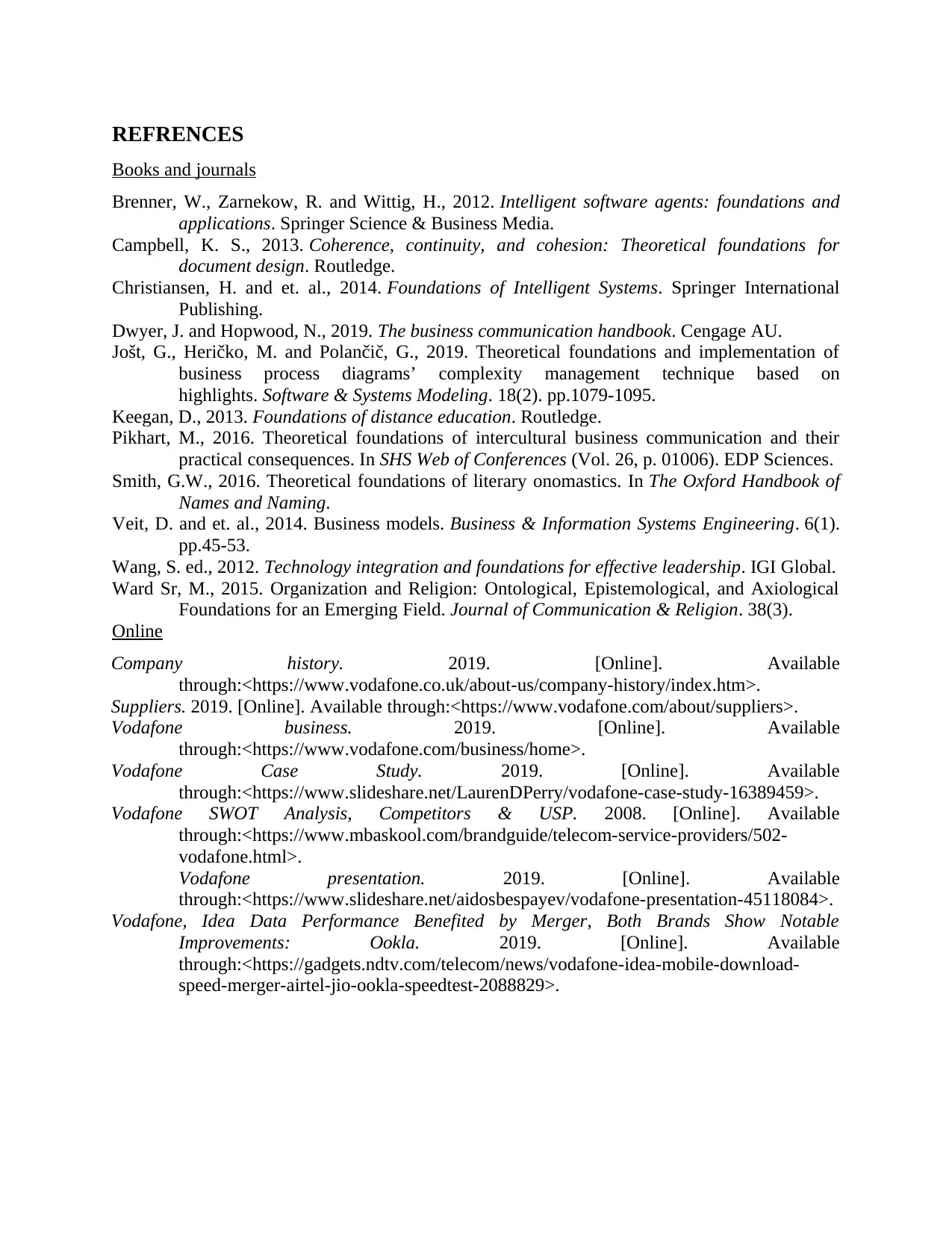
REFRENCES
Books and journals
Brenner, W., Zarnekow, R. and Wittig, H., 2012. Intelligent software agents: foundations and
applications. Springer Science & Business Media.
Campbell, K. S., 2013. Coherence, continuity, and cohesion: Theoretical foundations for
document design. Routledge.
Christiansen, H. and et. al., 2014. Foundations of Intelligent Systems. Springer International
Publishing.
Dwyer, J. and Hopwood, N., 2019. The business communication handbook. Cengage AU.
Jošt, G., Heričko, M. and Polančič, G., 2019. Theoretical foundations and implementation of
business process diagrams’ complexity management technique based on
highlights. Software & Systems Modeling. 18(2). pp.1079-1095.
Keegan, D., 2013. Foundations of distance education. Routledge.
Pikhart, M., 2016. Theoretical foundations of intercultural business communication and their
practical consequences. In SHS Web of Conferences (Vol. 26, p. 01006). EDP Sciences.
Smith, G.W., 2016. Theoretical foundations of literary onomastics. In The Oxford Handbook of
Names and Naming.
Veit, D. and et. al., 2014. Business models. Business & Information Systems Engineering. 6(1).
pp.45-53.
Wang, S. ed., 2012. Technology integration and foundations for effective leadership. IGI Global.
Ward Sr, M., 2015. Organization and Religion: Ontological, Epistemological, and Axiological
Foundations for an Emerging Field. Journal of Communication & Religion. 38(3).
Online
Company history. 2019. [Online]. Available
through:<https://www.vodafone.co.uk/about-us/company-history/index.htm>.
Suppliers. 2019. [Online]. Available through:<https://www.vodafone.com/about/suppliers>.
Vodafone business. 2019. [Online]. Available
through:<https://www.vodafone.com/business/home>.
Vodafone Case Study. 2019. [Online]. Available
through:<https://www.slideshare.net/LaurenDPerry/vodafone-case-study-16389459>.
Vodafone SWOT Analysis, Competitors & USP. 2008. [Online]. Available
through:<https://www.mbaskool.com/brandguide/telecom-service-providers/502-
vodafone.html>.
Vodafone presentation. 2019. [Online]. Available
through:<https://www.slideshare.net/aidosbespayev/vodafone-presentation-45118084>.
Vodafone, Idea Data Performance Benefited by Merger, Both Brands Show Notable
Improvements: Ookla. 2019. [Online]. Available
through:<https://gadgets.ndtv.com/telecom/news/vodafone-idea-mobile-download-
speed-merger-airtel-jio-ookla-speedtest-2088829>.
Books and journals
Brenner, W., Zarnekow, R. and Wittig, H., 2012. Intelligent software agents: foundations and
applications. Springer Science & Business Media.
Campbell, K. S., 2013. Coherence, continuity, and cohesion: Theoretical foundations for
document design. Routledge.
Christiansen, H. and et. al., 2014. Foundations of Intelligent Systems. Springer International
Publishing.
Dwyer, J. and Hopwood, N., 2019. The business communication handbook. Cengage AU.
Jošt, G., Heričko, M. and Polančič, G., 2019. Theoretical foundations and implementation of
business process diagrams’ complexity management technique based on
highlights. Software & Systems Modeling. 18(2). pp.1079-1095.
Keegan, D., 2013. Foundations of distance education. Routledge.
Pikhart, M., 2016. Theoretical foundations of intercultural business communication and their
practical consequences. In SHS Web of Conferences (Vol. 26, p. 01006). EDP Sciences.
Smith, G.W., 2016. Theoretical foundations of literary onomastics. In The Oxford Handbook of
Names and Naming.
Veit, D. and et. al., 2014. Business models. Business & Information Systems Engineering. 6(1).
pp.45-53.
Wang, S. ed., 2012. Technology integration and foundations for effective leadership. IGI Global.
Ward Sr, M., 2015. Organization and Religion: Ontological, Epistemological, and Axiological
Foundations for an Emerging Field. Journal of Communication & Religion. 38(3).
Online
Company history. 2019. [Online]. Available
through:<https://www.vodafone.co.uk/about-us/company-history/index.htm>.
Suppliers. 2019. [Online]. Available through:<https://www.vodafone.com/about/suppliers>.
Vodafone business. 2019. [Online]. Available
through:<https://www.vodafone.com/business/home>.
Vodafone Case Study. 2019. [Online]. Available
through:<https://www.slideshare.net/LaurenDPerry/vodafone-case-study-16389459>.
Vodafone SWOT Analysis, Competitors & USP. 2008. [Online]. Available
through:<https://www.mbaskool.com/brandguide/telecom-service-providers/502-
vodafone.html>.
Vodafone presentation. 2019. [Online]. Available
through:<https://www.slideshare.net/aidosbespayev/vodafone-presentation-45118084>.
Vodafone, Idea Data Performance Benefited by Merger, Both Brands Show Notable
Improvements: Ookla. 2019. [Online]. Available
through:<https://gadgets.ndtv.com/telecom/news/vodafone-idea-mobile-download-
speed-merger-airtel-jio-ookla-speedtest-2088829>.
⊘ This is a preview!⊘
Do you want full access?
Subscribe today to unlock all pages.

Trusted by 1+ million students worldwide
1 out of 12
Related Documents
Your All-in-One AI-Powered Toolkit for Academic Success.
+13062052269
info@desklib.com
Available 24*7 on WhatsApp / Email
![[object Object]](/_next/static/media/star-bottom.7253800d.svg)
Unlock your academic potential
Copyright © 2020–2025 A2Z Services. All Rights Reserved. Developed and managed by ZUCOL.





